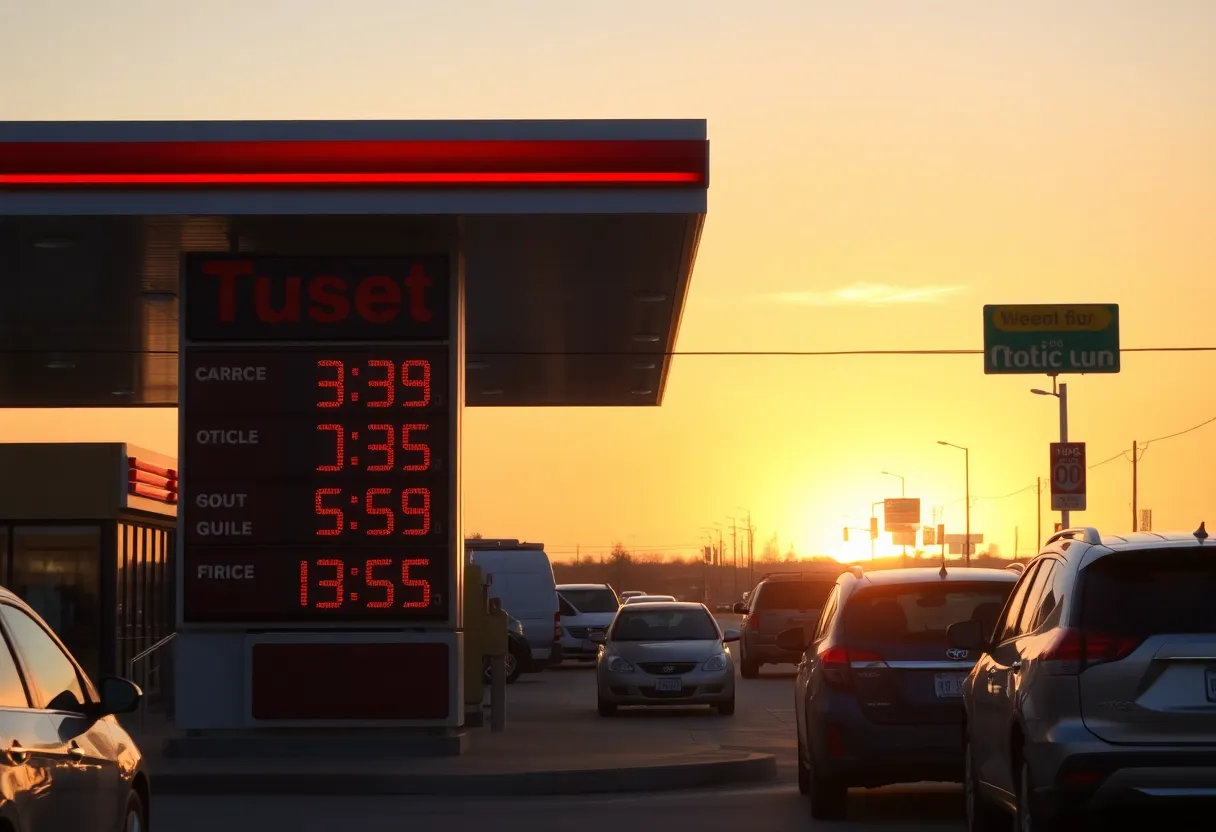Omaha, October 11, 2025
Gas prices in Omaha have decreased to an average of $3.15 per gallon. This 5 cent reduction provides slight relief for drivers and businesses amid fluctuating fuel costs. Experts attribute the drop to stable oil markets and seasonal demand patterns, advising businesses to prepare for potential increases as winter blends approach.
Gas Prices Decline in Omaha
Omaha – Gas prices in Nebraska have seen a slight decrease this week, with the average price per gallon in Omaha dropping to $3.15. This marks a reduction of 5 cents from last Friday, providing a minor financial relief for local drivers and businesses amid ongoing fuel cost fluctuations.
The decline is linked to stable oil markets and seasonal demand patterns. These factors have contributed to the lower prices, helping ease the burden on daily commuters and businesses that rely on fuel for operations. While the change is modest, it highlights broader trends in energy pricing that affect everyday expenses.
Experts point to the stability in oil markets as a key driver, noting that seasonal shifts in demand have played a role in this temporary dip. Additionally, the potential for future increases is a concern, particularly with the transition to winter fuel blends that could raise costs. Businesses are advised to prepare for these possibilities by adjusting their budgets to account for potential fluctuations.
This development comes as part of ongoing monitoring of fuel prices in the region, where economic factors continue to influence consumer spending. The drop offers a brief respite, but it underscores the need for awareness of how external market conditions can impact local economies.
Reasons Behind the Price Drop
The recent decrease in gas prices can be attributed to several factors. Stable oil markets have helped keep prices from rising, while seasonal demand has eased due to factors like weather and travel patterns. This combination has led to the current average of $3.15 per gallon in Omaha, down from the previous week’s levels.
Analysts observe that such stability often results from global supply dynamics, including production levels and international trade. In Nebraska, where fuel consumption varies with agricultural and commuting needs, these external influences play a significant role. The 5-cent reduction reflects a broader trend seen in similar markets, offering a positive note for consumers.
Implications for Businesses and Commuters
The lower gas prices provide immediate benefits, particularly for commuters who face daily travel costs. This relief could translate into savings for households and businesses that depend on vehicles for transportation and logistics. For instance, companies in sectors like delivery and agriculture may see reduced operational expenses in the short term.
However, experts caution that prices may not remain low. The shift to winter blends, which typically include additives for colder weather, could lead to increases. As a result, businesses are encouraged to factor these potential changes into their financial planning to avoid unexpected costs. This proactive approach helps maintain stability amid unpredictable energy markets.
Background on Gas Price Trends
Gas prices in Nebraska, like in other areas, fluctuate based on a variety of factors including global oil supplies, refining processes, and local demand. The current average of $3.15 per gallon in Omaha represents a slight reprieve from recent trends, where prices have been influenced by seasonal shifts and market stability. Historically, prices tend to vary with economic conditions, such as changes in crude oil production and distribution networks.
Over the past year, Nebraska has experienced ups and downs in fuel costs, driven by broader economic indicators. The recent 5-cent drop aligns with patterns observed during periods of stable oil markets, which can provide temporary easing of expenses. Experts continue to monitor these trends, advising that factors like weather-related demand could alter future prices.
This situation emphasizes the importance of energy market awareness for both individuals and businesses. By understanding these dynamics, stakeholders can make informed decisions about budgeting and resource allocation. As the region moves into different seasons, ongoing adjustments in fuel formulations may influence costs, making it essential to stay informed.
To expand on this topic, the dip in prices highlights how interconnected local economies are with global energy trends. For example, stable oil markets often result from balanced supply and demand worldwide, benefiting regions like Nebraska. Businesses can use this information to optimize their strategies, ensuring they remain resilient against potential price swings.
In summary, the current gas price reduction in Omaha offers a glimpse into the fluid nature of energy costs. With averages now at $3.15 per gallon, down 5 cents, the focus remains on sustainable practices and preparedness for future changes. This development underscores the need for continued vigilance in managing fuel-related expenses.
The article continues to explore related aspects, such as how these changes compare to historical data in Nebraska. Recent observations indicate that similar dips have occurred in the past, often tied to seasonal demand and market stability. This context helps illustrate the broader implications for the state’s economy, where fuel prices affect everything from personal budgets to business operations.
Furthermore, experts suggest that monitoring oil market trends is crucial for predicting future adjustments. The potential rise due to winter blends is a common occurrence, prompting recommendations for proactive budgeting. Overall, this week’s developments serve as a reminder of the ever-changing landscape of energy costs in Nebraska.
Expanding on Expert Advice
Professionals in the field emphasize the role of seasonal factors in price variations. For instance, lower demand in certain months can lead to reductions, as seen with the current 5-cent drop. Businesses are particularly advised to review their fuel expenditures regularly to adapt to these shifts effectively.
This comprehensive overview aims to provide readers with a clear understanding of the situation, ensuring they can navigate the implications with ease.
FAQ
- Q1: What is the current average gas price in Omaha? A1: Gas prices in Nebraska dipped slightly this week, averaging $3.15 per gallon in Omaha.
- Q2: How much did gas prices change from last Friday? A2: Gas prices in Nebraska dipped slightly this week, averaging $3.15 per gallon in Omaha, down 5 cents from last Friday.
- Q3: What factors are causing the drop in gas prices? A3: Analysts attribute the drop to stable oil markets and seasonal demand.
- Q4: What advice is given to businesses regarding gas prices? A4: Experts warn of potential rises with winter blends, advising businesses to budget accordingly.
Key Features Chart
| Feature | Details |
|---|---|
| Current Average Price | $3.15 per gallon in Omaha |
| Price Change | Down 5 cents from last Friday |
| Reasons for Drop | Stable oil markets and seasonal demand |
| Potential Risks | Rises with winter blends |
| Advice for Businesses | Budget accordingly for potential increases |
Deeper Dive: News & Info About This Topic
HERE Resources
Omaha Faces Surge in Flu Cases as Hospitals See Rise in Pediatric Admissions
Pleasant Weather Brightens Omaha Following Recent Rains
Gas Prices Drop Nationwide, Providing Relief for Drivers
Omaha Weekend Events Offer Fun for Everyone
Nebraska Gas Prices Decrease, Providing Relief to Drivers
Global Market Opens in Omaha with State Support
Nebraska Gas Prices See Recent Decline





